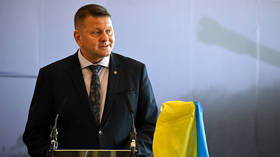Russia’s deployed nuclear capacity overtakes US for first time since 2000

Russia has 1,643 nuclear missiles ready to launch – one more than the US – according to an official State Department report. Both countries have been upgrading their active nuclear arsenals since the outbreak of the Ukrainian conflict.
The US report is based on official figures exchanged between the two countries as part of the New START disarmament treaty, and includes missiles deployed before September 1. The numbers show a significant increase from March, when data showed that Washington had a capacity of 1,585 payloads, and Moscow 1,512.
The current figures are in violation of the New START treaty,
signed in 2010 by Barack Obama and then-President Dmitry
Medvedev, during the short-lived reset in relations between the
two states, which prescribe a limit of 1,550 deployed warheads.
Overall, the authoritative Center for Arms Control and
Non-Proliferation believes Moscow has more than 8,000 warheads,
and Washington over 7,000, although not all of them can be
allocated to efficient delivery systems.
Russia recently announced a planned overhaul of its entire
nuclear arsenal by 2020, as part of a wider rearmament program
that has been budgeted at $700 billion.
Although Moscow has not provided a detailed breakdown of how it
achieved the upgrade of nuclear capacity over the past months,
experts on both sides of the Atlantic have speculated that the
rise has been due to the armament of one – or possibly two –
Borei-class nuclear submarines.

Those are equipped with Bulava missiles – widely considered one of the most expensive projects in Russia’s military history – which, after problem-plagued gestation, have finally been deemed ready for deployment.
Russian President Vladimir Putin has recently boasted that the supersonic missiles, which can rapidly change their trajectory, cannot be shot down by any missile defense system in the world, however sophisticated.
Russia has also invested in mobile Yars systems, and there are plans to revive the nuclear missile trains common in Soviet times.
Washington has expressed increasing alarm at the Kremlin’s rearmament drive, with emotions running high after the Obama administration accused Moscow of violating the 1987 Intermediate-Range Nuclear Forces Treaty (INF) in July, with its Iskander class missiles, prompting sharp denials and counter-accusations from Moscow.
“The Russian deception of negotiating a nuclear arms reduction while building up nuclear arms poses a direct threat to the United States,” Jim Inhofe, a member of the Senate Armed Services Subcommittee on Strategic Forces, wrote in an editorial last month, accusing the US of reducing its nuclear forces as Russia races ahead.
“It is too late to negotiate the Russians back into compliance. They have tested this capability and we have no way to know for certain whether they will deploy these systems.”
While the figures may look alarming, the total numbers for both countries remain far short of their 1980s peaks, when the Soviet Union alone possessed over 40,000 warheads.
“I don’t think we are on the verge of a new arms race. At least, Russia definitely won’t be part of it,.In our case, it’s just that the time has come for us to modernize our nuclear and conventional arsenals,” Russia's Foreign Minister Sergey Lavrov told RT last month.
“The US nuclear arsenal is somewhat younger than ours, but perhaps it is also time for them to upgrade it. I just hope that the US will abide by the provisions of the New START treaty, which are legally binding.”














